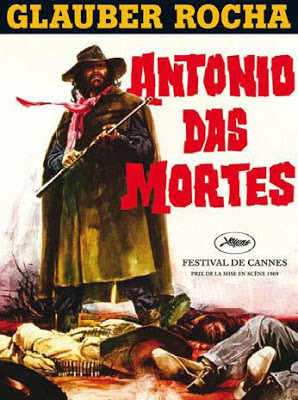à propos de la remarquable soprano de la fameuse scène de la mort d'Antonio das Mortes
(cf
l'article précédent sur "beyond the coda"), le compositeur Marlos Nobre nous a fourni les détails suivants :
"I inform that, in the music of the death scene, the singer is a famous dramatic soprano, soloist
at the Opera of the Colon Theatre in Buenos Aires. Her name is Amalia Bazan and she recorded the music with myself conducting with fine musicians of the Rio de Janeiro's Opera Theater. The work which the title is UKRINMAKRINKRIN is recorded on a double CD, with the same performers and my conducting,
with the title "Marlos Nobre Orchestral, Chamber and Vocal Works" still available
on the label Leman Classics Switzerland"
et à propos de
Maria Bethânia, qui avait participé à la musique du film:
....
Vous avez eu un autre ennemi: Glauber Rocha.
On ne s'est pas disputé, non. Mais quand Glauber a fait "O Dragão da Maldade Contra o Santo Guerreiro", en 1969, j'ai chanté une chanson dans le film chanson qu'il a coupé. C'était un verset: "Será que o sol quebra a vidraça / Será que o sol vai quebrar?". C'est tout. J'ai enregistré sur deux jours, seulement parce que j'ai aimé Glauber et que ma meilleure amie était sa sœur, Anecy Rocha. Glauber était un Dieu. Travaillant nu à la maison, il créait un climat. Anecy disait: «Bethânia, ne va pas là parce que Glauber travaille», et je savais ce que cela signifiait: ". Glauber est nu. Ils mourraient de rire, j'étais très tendue et Anecy essaya de me détendre...
Pourquoi Glauber a-t'il coupé la scène musicale?
Je ne sais pas. Anecy m'a expliqué qu'il a dû enlever la séquence entière. Bien sûr, je n'ai jamais gagné quoi que ce soit, imaginez : Glauber, m'inviter? Un luxe! Seulement un jour, j'étais au bar Zeppelin (Ipanema) quand Odette Lara, qui était une actrice dans le film, est venu à la table et a fait quelques très mauvaises critiques, mettant tout en bas. Et moi, bien sûr, j'ai réagi, j'étais en colère.
Vous avez continué d'être amie de Glauber jusqu'à sa mort?
On se voyait beaucoup, à Paris, lui et son épouse, Juliet Berto. C'était une belle française que j'aimais bien, avec qui il a eu sa dernière maison en France, et lors d'un spectacle que j'ai fait à l'Olympia, elle m'a donné toutes les reliques de Glauber: photos, lettres, affiches de cinéma, extraits de presse. Elle m'a fait confiance et je les ai donné directement à la mère de Glauber Rocha, Tante Lucy.
....
Maria Bethânia
....
LES LIMITES DE LA CREATION - Selon ses plus intimes, Glauber se ferme quand il commence un film. Lors de la préparation du script de son premier long métrage, "Barravento" la chanteuse Maria Bethânia, amie de sa sœur Anecy, allait à sa maison de Salvador pour jouer de la guitare et chanter. Glauber, enfermé dans sa chambre, cria:
"Silence! Quelle femme chiante!" La relation entre les deux, au début pleine de débordements, s'est s'adoucie avec le temps. Glauber l'appelait par son nom complet, Maria da Purificação Bethânia. Pour elle, Glauber était
"un timide qui s'extraderait dans ses films". Quand il a réalisé "Antonio das Mortes" , Glauber a invité Bethânia à chanter sur la bande sonore.
"J'ai eu peur. La musique était difficile, semblait plus un aria pour une chanteuse d'opéra. J'ai presque abandonné". Bethânia a passé des journées à étudier la composition et l'enregistrement, mais lentement est devenue confiante.
"Glauber m'as dirigé tout le temps comme s'il dirigeait un acteur".
DIEU EXISTE? - La musique de "Antonio das Mortes," du jeune compositeur Marlos Nobre, reflète les préoccupations esthétiques de Glauber, un
«torturé de la forme», selon ses amis. Bethânia chante à la fin du film, seulement quatre versets ("Se aprepara gente / Se aprepara que agora vai ter / Le Duel of the Evil Dragon / Contre le Saint-Guerrier"), répétés en plusieurs tonalités. Le texte est basé sur les bandits légendaires de Lampião qui avaient l'habitude de ne parler qu'en vers. Une fois quelqu'un lui a demandé comment il expliquait la virginité de Marie après la naissance de Jésus et le bandit a répondu:
"Tout comme le soleil se déplace à travers la fenêtre sans casser la vitre". Glauber croit-il en Dieu?
"Il ne boit pas et n'est pas religieux, en dépit de la forte dose de mysticisme de ses films", explique l'acteur Mauricio do Valle, l'interprète de Antonio das Mortes. Lors du tournage de "Le Dieu noir et le Diable blond" (Deus e o Diabo na Terra do Sol) à l'intérieur de Bahia, Glauber et Mauricio grimpaient sur une colline en discutant à propos de Dieu. Soudain, une rafale de vent a frappé la caméra, qui roula à quelques mètres plus bas. Mais le matériel était intact. Mauricio do Valle, qui est très religieux, a déclaré:
"Dieu existe". Glauber a dit:
"C'est possible ..."
....
extrait d'un article dans le magazine Veja de mai 1969
thanks to Stephane P. & Lisa C. for researches & translations

.jpg)
















































